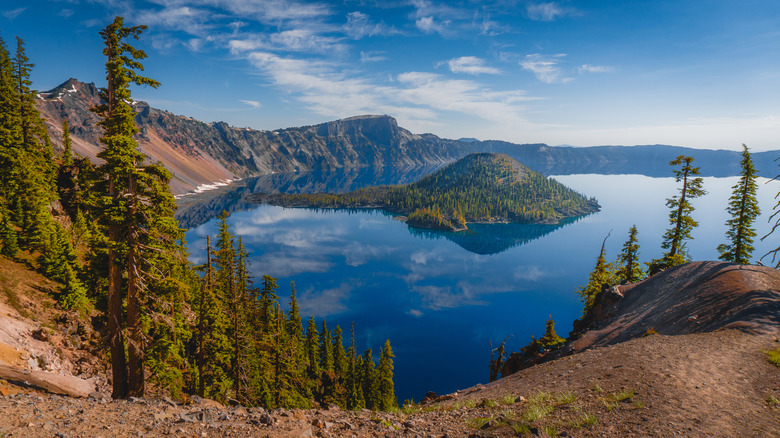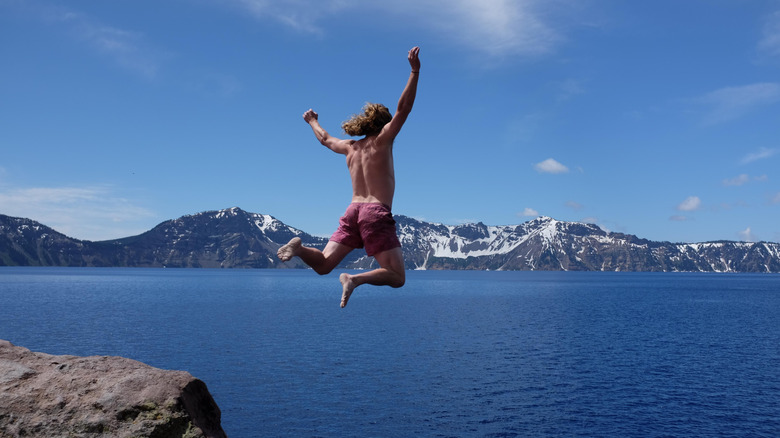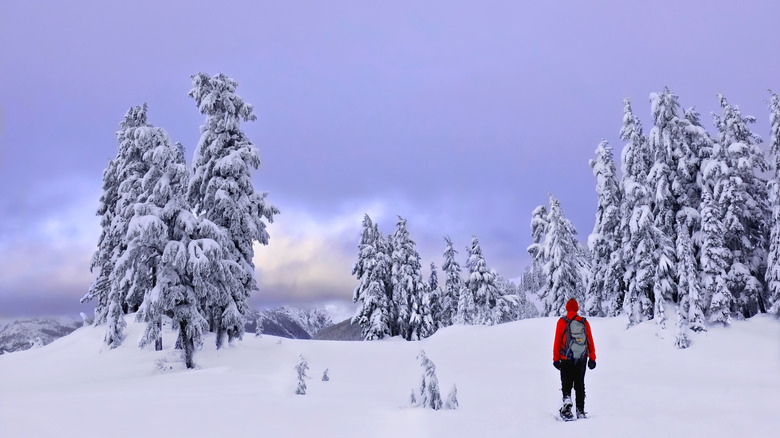Why Tourists Will Want To Visit Oregon's Breathtaking Crater Lake National Park Before 2026
While Oregon has no shortage of gorgeous outdoor gems — like this budget-friendly beach – Crater Lake isn't just the state's only national park: at 1,949 feet from surface to bottom, it's also the deepest lake in America. Formed 7,700 years ago during a massive volcanic eruption, this caldera is one of the Beaver State's crown jewels. The park attracts around 500,000 visitors each year who come to hike, marvel at the rugged outdoor spectacle, take a cruise, and — for those willing to brave the cold — plunge into the dazzling blue waters.
However, 2025 will be the last year for visitors to take that chilly dip for some time. The National Park Service has announced that the Cleetwood Cove Trail — the rocky, precipitous path that is the only point of access for the whole lake — will be closed for repairs until most likely the summer 2029. While visitors to the park will still be able to marvel at Crater Lake's soul-stirring vistas from the rim of the caldera, heading down to the water won't be an option. This means that both swimming and lake cruises on the park's concession boats will be put on hold until further notice.
The Cleetwood Cove Trail is in disrepair
Established as a national park in 1902, Crater Lake occupies an area of 20 square miles, while the crater itself is 27 square miles in total area. It's the fifth-deepest lake on the planet, and the sheer cliffs that make up the walls of the crater rise up to 2,000 feet above the surface of the water. This means that the lake is extremely difficult to access, and while some have tried (illegally) to climb down the steep cliffs to the lake's surface, it has at times resulted in injury and even death.
As a result, the 1.1-mile Cleetwood Cove Trail has long served as the lake's sole point of access. Over the years, overuse, the lake's harsh weather, and the rigors of time have caused the trail to break down, increasing the risk of rockfall. The retaining walls that support the path's switchbacks have begun to fail, and the bulkhead and dock used by the cruise boats and park's watercraft are in dire need of repair. Add a pair of undersized, outdated restrooms, and you have a sizable construction project on your hands.
According to the National Park Service, construction to restore the trail and lakeshore infrastructure will begin in 2026, which means visitors have one more summer to jump on a cruise or get a bracing swim in. The elevation of Crater Lake's rim ranges from 7,000 to 8,000 feet, which means summers — construction season — are short. With an average snowfall of 53 feet, the park is buried for much of the year, so crews will only be able to work for a few months at a time, which stretches the whole process out.
Other things to do at Crater Lake National Park
While swimming and boat cruises may be off the menu for a few years, Crater Lake still offers plenty of activities for visitors willing to make the trip. The crater is circled by a 33-mile-long road, making the scenic Rim Drive a must-do activity. With a gentle, winding route designed to highlight the natural surroundings, the Rim Drive also features picnic areas, ample parking, and over 30 overlooks where you can stop to take in the heavenly views.
For those keen to work up a sweat, cycling the rim is also an option, and the park also boasts plenty of opportunities for hiking. The popular Watchman Peak Trail is a 1.6-mile in-and-out route leading to a fire lookout that provides 360-degree vistas of the lake and beyond (making it a perfect place to catch the sunset), while the 4.4-mile Mt.Scott Trail allows hikers to ascend the 8,929-foot peak of the same name, which offers the only view of the entire lake of in the park.
Crater Lake National Park's lofty elevation and ample snowfall turn it into a winter wonderland during the cold months of the year. This makes it an ideal destination for enthusiasts of snowshoeing and cross-country skiing, especially through the many meadows on the mountains surrounding the lake. The park is also an ideal place for stargazing and has been listed as one of the nation's top 10 dark sky locations in the national park system. While you're in southern Oregon, head over to the artsy and outdoorsy burg of Ashland, named America's coziest college town.


